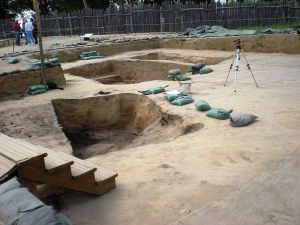
Archaeologists excavating at Jamestown, Virginia, the site of America’s first successful English colony, have uncovered two deep posthole features 24 feet apart in the area of the 1607 James Fort, evidencing a possible structure that has not heretofore been discovered among the many finds and features that have already come to light at the historic excavation site.
A posthole in archaeology is a patch, usually circular, of darker or discolored earth that reveals the location of timber or a wood beam that was placed in the ground to support or define a structure that once existed at a site. Being organic, the timber or wood beam usually would have long decomposed, leaving a visible trace in the soil that archaeologists can recogize while excavating.
Dr. William M. Kelso, head of archaeological research at Historic Jamestowne, believes the structure could be one of several possible constructions by early colonists at the Fort site: a blockhouse, a paling wall, or features of the corners of separate buildings. The archaeologists point out that historical accounts record the existence of a blockhouse and a paling wall.
Regarding the former, they state that the literature refers to the colonists taking refuge within a blockhouse near the end of the “starving time” winter of 1609-1610, when about two-thirds of the colonists died. Lord De La Warr is recorded to have arrived on a resupply ship in June 1610 to find the fort in a dilapidated condition. “Only the blockhouse,” wrote De La Warr, “somewhat regarded, was the safety of the remainder that lived, …” William Strachey, a writer-historian and short-term Jamestown colonist, in his account of that winter, also wrote “And it is true the Indian killed as fast without, if our men stirred but beyond the bounds of their blockhouse, …”
Strachey also described a wall, known as a paling, which was typically made of planks and posts, to the East of the original triangular palisade wall of the 1607 James Fort. Said Kelso, “having posts in that kind of wall that are 24 feet apart is a long distance, but it could be. Making trees into clapboards, flat and rough, means you can get more of a wall out of fewer trees.”*
The first posthole was found in August, 2013, in the vicinity of a visitor walkway. The second was found in September to the south of the first. In their attempt to further define the structure, they then opened a new excavation section to the east of the second to find a possible third posthole that they suspect may be 12 feet away. But there is still a lot more work ahead of them before they can draw any conclusions.
“We are speculating at this stage and we won’t know any time soon because we have a lot of dirt to move,” Kelso said.*
More information about this and the excavations at Jamestown can be obtained at the Jamestown Rediscovery website.
Image, Top Left: Credit Sarah Stierch (CC-BY-4.0), Wikimedia Commons
_______________________________________________________________________________________________________________________
__________________________
* http://www.historicjamestowne.org/the_dig/
Cover Photo, Top Left: Archaeological dig at Jamestown. Sarah Stierch, Wikimedia Commons
_______________________________________________________________________________________________________________________
Read about the most fascinating discoveries with a premium subscription to Popular Archaeology Magazine. Find out what Popular Archaeology Magazine is all about. AND MORE:
 Popular Archaeology’s annual Discovery edition is a selection of the best stories published in Popular Archaeology Magazine in past issues, with an emphasis on some of the most significant, groundbreaking, or fascinating discoveries in the fields of archaeology and paleoanthropology and related fields. At least some of the articles have been updated or revised specifically for the Discovery edition. We can confidently say that there is no other single issue of an archaeology-related magazine, paper print or online, that contains as much major feature article content as this one. The latest issue, volume 2, has just been released. Go to the Discovery edition page for more information.
Popular Archaeology’s annual Discovery edition is a selection of the best stories published in Popular Archaeology Magazine in past issues, with an emphasis on some of the most significant, groundbreaking, or fascinating discoveries in the fields of archaeology and paleoanthropology and related fields. At least some of the articles have been updated or revised specifically for the Discovery edition. We can confidently say that there is no other single issue of an archaeology-related magazine, paper print or online, that contains as much major feature article content as this one. The latest issue, volume 2, has just been released. Go to the Discovery edition page for more information.
Subscription Price: A very affordable $5.75 for those who are not already premium subscribers of Popular Archaeology Magazine (It is FREE for premium subscribers to Popular Archaeology). Premium subscribers should email [email protected] and request the special coupon code. Or, for the e-Book version, it can be purchased for only $3.99 at Amazon.com.





